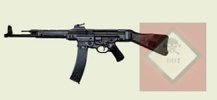...which by now, some of the more serious gun nuts may be able to ID. If not, I present you with my newest money pit...

A numbers-matching, GI-bringback, 1944 Berliner-Lubecker Machinenfabrik, or BLM Gewehr 43*. An upgrade of an earlier gas-trap design the G.41, the G.43 (later K.43... name changed to Karabiner 43 for PR purposes) was a gas-piston version that was a much improved design and more similiar to its inspiration, the Soviet SVT-38/40. The G/K 43 was a problem-plagued rifle throughout its life. Overly complex in its design (taking this thing apart is an adventure), it wasn't the optimal battle rifle, but finally gave the Wermacht a weapon that was equivalent to the M1 Garand and SVT-38/40 in firepower

Below the rifle in both pictures are the spare firing pin, firing pin extension, and original manual that were all included inside the buttstock.
*Gewehr is German for rifle. German weapon designations were based on the type of weapon it was (G/K/MP/MG/FG/etc..) and the year it was introduced -- different then the arbitrary American method.

A numbers-matching, GI-bringback, 1944 Berliner-Lubecker Machinenfabrik, or BLM Gewehr 43*. An upgrade of an earlier gas-trap design the G.41, the G.43 (later K.43... name changed to Karabiner 43 for PR purposes) was a gas-piston version that was a much improved design and more similiar to its inspiration, the Soviet SVT-38/40. The G/K 43 was a problem-plagued rifle throughout its life. Overly complex in its design (taking this thing apart is an adventure), it wasn't the optimal battle rifle, but finally gave the Wermacht a weapon that was equivalent to the M1 Garand and SVT-38/40 in firepower

Below the rifle in both pictures are the spare firing pin, firing pin extension, and original manual that were all included inside the buttstock.
*Gewehr is German for rifle. German weapon designations were based on the type of weapon it was (G/K/MP/MG/FG/etc..) and the year it was introduced -- different then the arbitrary American method.

